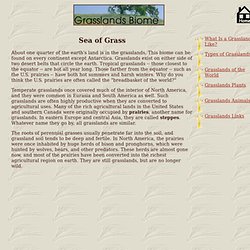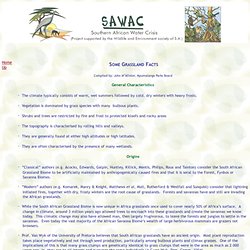

Grassland Biome. KDE Santa Barbara. Location | Weather | Plants | Animals | People | Links LOCATION: The name for this biome, temperate grasslands, is a great description for what it is like here.

The most important plants in this biome are grasses! Temperate grasslands have some of the darkest, richest soils in the world (not in wealth, but in nutrients). People who live in grassland regions often use these soils for farming. WEATHER: Temperatures in this biome vary greatly between summer and winter. PLANTS: Grasses dominate temperate grasslands. ANIMALS: All grasslands share a lack of shelter from predators, and an abundance of grass for food; therefore, grassland animal populations are similar throughout the world. PEOPLE AND THE TEMPERATE GRASSLAND: One of the main environmental concerns regarding temperate grasslands is the conversion of grassland to farmland. The Grassland Biome Geography for Kids: Grassland Biomes Grassland Explorer Blue Planet Biomes: Grasslands Prairies in the Prairie State Back to Biomes Index.
Grasslands. Modern agriculture does make some nods to these problems.

Crop rotation, where one crop is grown in a field one year and another crop the next, does much to combat the worst problems of pest buildup and soil nutrient exhaustion in fields. In many cases, corn is rotated with soybeans; the latter are legumes which harbor Rhizobium, an endosymbiotic bacterium which converts atmospheric nitrogen into a form that plants can use to make proteins. In this way, planting soybeans (or alfalfa) may increase the nitrogen content of the soil and reduce the need for nitrogen-based fertilizers. In any event, agricultural systems displace natural communities; given the world's need for food to feed the human population (and we're now raising corn to convert into ethanol to fuel our cars!) This is not due to change anytime soon. As an aside, it should be pointed out that not all of our agriculture is for food. Today, a top area of research is prairie restoration.
Grasslands Biome. About one quarter of the earth's land is in the grasslands.

This biome can be found on every continent except Antarctica. Grasslands exist on either side of two desert belts that circle the earth. Tropical grasslands -- those closest to the equator -- are hot all year long. Those farther from the equator -- such as the U.S. prairies -- have both hot summers and harsh winters. Why do you think the U.S. prairies are often called the "breadbasket of the world? " Temperate grasslands once covered much of the interior of North America, and they were common in Eurasia and South America as well. The roots of perennial grasses usually penetrate far into the soil, and grassland soil tends to be deep and fertile. The grassland biome. Online exhibits : The world's biomes The grassland biome Grasslands are characterized as lands dominated by grasses rather than large shrubs or trees.

In the Miocene and Pliocene Epochs, which spanned a period of about 25 million years, mountains rose in western North America and created a continental climate favorable to grasslands. Ancient forests declined and grasslands became widespread. Following the Pleistocene Ice Ages, grasslands expanded in range as hotter and drier climates prevailed worldwide. Savanna Savanna is grassland with scattered individual trees. Basic Facts About Grasslands. Imagine American Prairie Reserve. Grassland Facts. Compiled by: John McAllister, Mpumalanga Parks Board General Characteristics · The climate typically consists of warm, wet summers followed by cold, dry winters with heavy frosts. · Vegetation is dominated by grass species with many bulbous plants. · Shrubs and trees are restricted by fire and frost to protected kloofs and rocky areas · The topography is characterised by rolling hills and valleys. · They are generally found at either high altitudes or high latitudes. · They are often characterised by the presence of many wetlands.

Origins · “Classical” authors (e.g. . · “Modern” authors (e.g. . · While the South African Grassland Biome is now unique in Africa grasslands once used to cover nearly 50% of Africa’s surface. . · Prof. Water Supply · Montane grasslands and fynbos are the great “collectors” of rain water in South Africa. Species Diversity Plants · Botanically grasslands support 81 species per 1 000 m². Birds Reptiles and amphibia Butterflies Mammals Economics Conservation Status. Tanzania Safari: What a sound! 22 lions roar. Elephants. Savanna.